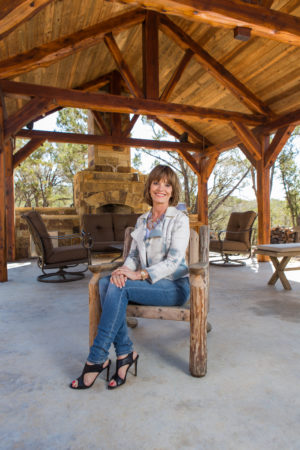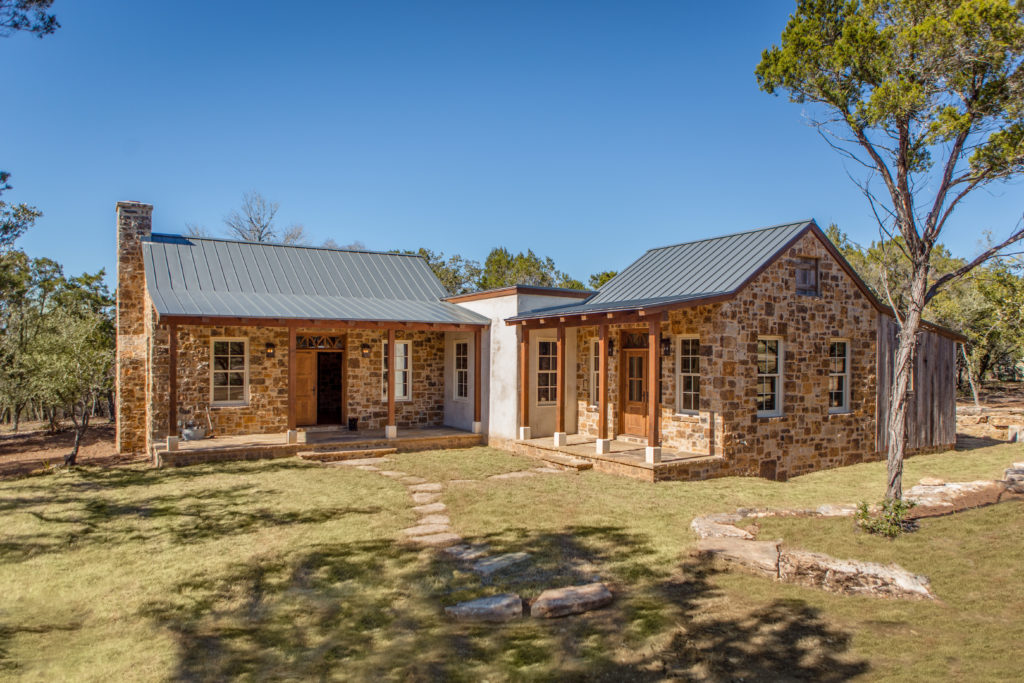Whether she is in the thick of things in the teeming metropolis or off the grid in Wimberley, she is building the future from the ground up.
By Steve Uhler

Jan Ryan is leading a double life. Look fast enough and any weekday, you can spot her just about anywhere, make that everywhere in or near Austin. As one of the busiest and most celebrated serial entrepreneurs and social-technology execs in a city where you can’t throw an iPhone without hitting one, Ryan is a whirlwind of activity. Pausing during an early morning bike ride in her Barton Creek neighborhood, she punches up her schedule for the day:
8:30 a.m.: Board planning call for CEO Summit, Austin Technology Council
9:30 a.m.: Client meetings with early stage startup
12:30 p.m.: Lunch downtown
2 p.m.: Capital Factory pitch-practice coaching for new founders
5 p.m.: Teleconference with co-lead of upcoming SXSW panel
6:30 p.m.: Facilitate Women@Austin forum at Capital Factory
Jan Ryan knows a lot about entrepreneurship and startups. She’s built her share of them, resulting in four successful acquisitions and one IPO. Moving to Austin in 1996 as the vice president of worldwide sales for Vignette Corporation, she went on to raise $7 million in funding to launch Rome Corporation, a software startup, in 2001. Eight years later, she founded Social Dynamx, an early social customer-care platform designed for the needs of big businesses. The venture was so successful that within two years, Lithium Technologies acquired the company. In 2013, Ryan became a partner and mentor at Capital Factory, the Austin-based incubator and mentoring program for startups. She’s also the founder and CEO of Women@Austin, the nonprofit community that actively supports and promotes women entrepreneurs.
“Some people just complain about the way things are. Jan Ryan did something about it,” says Joshua Baer, co-founder and CEO of Capital Factory. “She pays it forward to first-time entrepreneurs. Austin wouldn’t be the same without her!”
Ryan has a gift for bringing concepts into tangible, profitable existence, with a touch that borders on entrepreneurial alchemy.
“I love to create things out of nothing,” she says. “It’s my passion.”
No doubt about it: Ryan loves building things from the ground up.
But then there’s the other side of Jan Ryan. Come the weekend, she eschews her fashionable business attire in favor of scuffed jeans and leather work gloves, and she and her husband of 35 years, Bob, take an hour-long commute deep into the Hill Country to their “other life” at 3 Hills Ranch. Far away from the chaotic hubbub of the city, the Ryans are busy shaping a totally different type of landscape, both literally and figuratively.
Nestled among a dense grove of oak, cedar and elm trees at the end of a seemingly endless dirt drive, 3 Hills Ranch is not only off the beaten path, it’s also 100 percent off the grid, a combination flagship of sustainable living, nature retreat and spiritual sanctuary rolled into one.
The project started modestly enough. On Valentine’s Day five years ago, the couple closed a deal on a parcel of raw acreage just outside Wimberley, Texas, with the vague vision of building a simple cabin for weekend retreats and recreation.
“I remember we actually built a heart shaped out of stones we collected that day, right in the middle of this clump of trees to celebrate,” Ryan recalls, smiling at the memory. “By a bizarre coincidence, that actually became the very spot we built on.”
The couple began spending their weekends together on the property, clearing trees and brush, getting familiar with the terrain and blue-sky ideas. As they spent more time on the land, the dream for a simple cabin grew into something else, something bigger.
“The land really spoke to us and told us what felt right,” says Ryan, with nary a hint of New Age irony. “In many ways, this project sprouted out of the soil. It wasn’t an overnight decision to create an off-the-grid ranch. It was kind of a natural evolution of following after another dream, which was this cabin we wanted to build for a retreat, to get away from the city and back to nature.”
The more time they spent on the property, the less drawn they were to traditional methods of architecture and building.
“We didn’t bring in a team to clean-cut everything,” Ryan says. “Yuppies are notorious for doing that. We actually decided to go out every weekend and do everything ourselves. By doing that, we were able to know the land, and a vision gradually took shape. A couple of years of doing that was incredibly good therapy. We both have very busy lives in the city, and it enabled us on weekends to have that yin and yang, just completely distraction-free.”
The actual construction process was unique.
“We sort of did things backward,” Ryan says. “We built an outdoor pavilion first. It’s a 16-by-32 timber frame with [a] dry stack fireplace and outdoor kitchen. So right in the middle of this acreage, we had this terrific outdoor pavilion. We had to power it somehow, so we used solar.”
The Ryans sought out the expertise of Native builders, a local sustainable-living construction company specializing in installing solar systems.
“I remember flipping the switch, turning it on. It was almost otherworldly. The music, the lights, everything just worked!” Ryan recalls, her face lights up at the memory.
“We built the pavilion first, and then the house three years later,” Ryan explains.
Securing the services of Tony Martin Inc., the renown Fredericksburg, Texas-based design and building company specializing in antique and reclaimed materials, they decided to go as green as possible. The main ranch house evolved into more of an extension of the environment than an intrusion on it.
“The great thing about working with Jan and Bob was how involved they were,” says Ira Martin, principle designer. “Ultimately, it’s their house. Basically, we designed the ranch house off the historic vernacular architecture of the Hill Country."
By the time they began laying the foundation for the ranch house two years ago, the Ryans were converts to a sustainable-living ethos and going totally off the grid.
“We used all natural materials to build the home: different types of stone, reclaimed woods, copper and other metals. We’re using a lot of cottons and natural furnishings inside, as well,” Ryan says.
From outside, the ranch house evokes a modified antique German Sunday house, part fitted stone, part aged wood, all designed to give the illusion of a century-old edifice that’s been incrementally and lovingly eased into the 21st century. A perpetual breeze graces the front porch, a blessing during brutal Texas summers. All heating and cooling for the ranch house is geo-thermal, all energy is solar-driven, and all the water is drawn directly from the property.
Step inside, and delightful touches abound: a cozy sleeping cubbyhole, invitingly perfect for reading and napping; an airy and open chef’s kitchen, complete with a Wolf Range; a mud room with hidden, recessed washer and dryer. Reclaimed materials adorn and accent the interior: a pair of latticed windows, circa 1900, recovered from a pastor’s study in Pennsylvania; another antique window from Germany, repurposed into a stylish bathroom mirror; rough-sawn ceiling beams brought in from an abandoned Ohio barn. The entire house exudes a rococo, elegant simplicity.
“Several years ago, I read a book by Sarah Susanka, The Not So Big House,” Ryan explains. “She’s an architect and the book impacted me a lot. She writes about if you want to have that ‘special home’ feeling, don’t go for a lot of square footage. Surround yourself with things you love and exclude everything else. When you start to bring ceilings down and go back to the values and things you love, it really makes a difference.”
The dichotomy between Jan Ryan’s city-based life as busy, technology-dependent entrepreneur, and alternate off-the-grid sustainable-living advocate may appear extreme, but the gulf isn’t as wide as it seems. They are two separate but complementary halves of a whole embracing similar skill sets.
“I’ve always had a high level of energy and curiosity, and I’m fascinated by the latest technology,” she points out. “It’s part of what I do as an entrepreneur. I promise you that clean energy and sustainable living is huge in this wave that’s coming. So it’s natural that I’d be interested in it. That absolutely is connected. You’re discovering something new and trying to bring it into reality.”
Though the house itself is complete, the project is far from finished. The couple is contemplating next steps, possibly adding a smaller guest cottage, a corral, maybe a fishing cabin. But they’re in no hurry.
“We’re doing this for ourselves, something we feel organically is the right thing to do. We also want to be able to give back in the right way toward a sustainable future. This is an opportunity to collect and share the information that was hard for us to get,” Ryan says. “A lot of the information is just not there. You end up feeling, ‘Why is our nation not doing more of this? Why are we so stuck on fossil fuels when this is not that hard?’ ”
Lounging on the front porch, Ryan savors the silence around her.

“I love being able to reflect here,” she says. “When you’re closer to nature, you recharge. That’s where I get my creative juices as an entrepreneur. You have to have that white space to recharge and think. … When I’m in the city, I’m living an interrupted life. Here, I can literally spend hours with my 4-year-old granddaughter getting in the dirt, looking at wings of bugs and be just as happy as I can be. Discovering small pebbles, collecting flowers in a mason jar, seeing things through her eyes: Those simple things are just delightful when you have a granddaughter.”
Tomorrow, Ryan will be back in the city, renewed, refreshed, recharged. But on this cool spring evening, she lingers on the porch, scanning the horizon, tracking the fading image of the late-evening sun dipping slowly below the tree line.
“We’re building this as a legacy, something to hand down to our children and grandchildren,” she reflects. “This is meant to last. This house is not going anywhere.”
Neither is Jan Ryan. Like 3 Hills Ranch and the land it stands on, this lady was built to endure.








